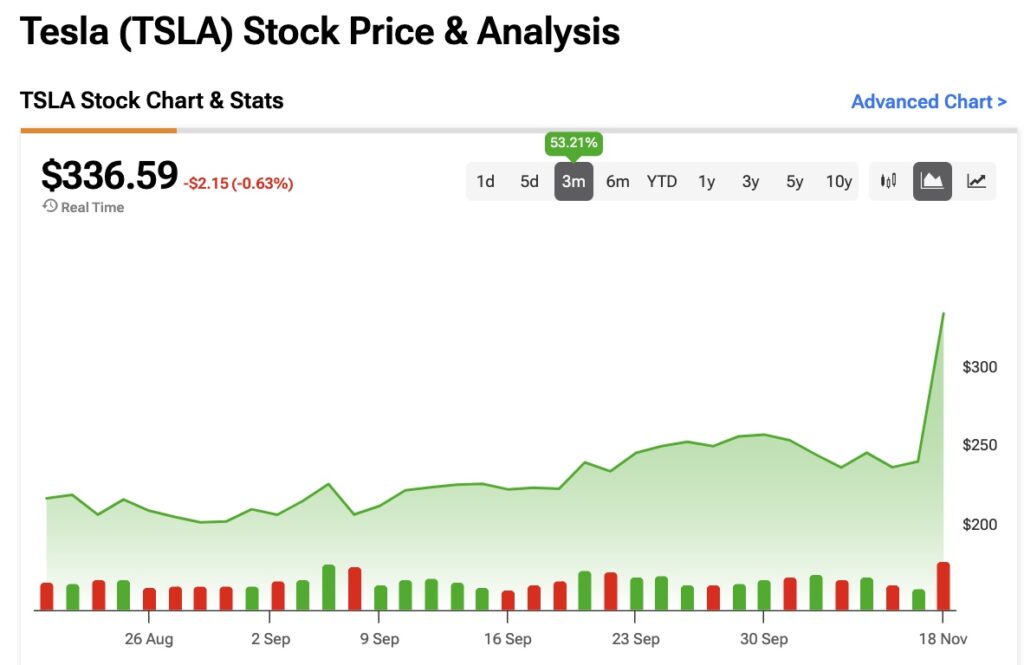Tesla (TSLA) stock has reached new yearly highs in recent weeks, largely fueled by President Donald Trump’s election victory, with CEO Elon Musk securing a position in his administration as the head of the “DOGE” (Department of Government Efficiency). As a long-term Tesla bull, I view this development as a significant win for the company, particularly regarding its position in China, the issue of tax credits, and, most importantly, its future in AI, Full-Self Driving (FSD), and autonomous vehicles.
Stay Ahead of the Market:
- Discover outperforming stocks and invest smarter with Top Smart Score Stocks
- Filter, analyze, and streamline your search for investment opportunities using Tipranks' Stock Screener

In this article, I’ll explain why Tesla stands to benefit greatly from the U.S. election outcome and how this new development adds a fresh layer of bullishness to the stock.
Musk Banks on Trump to Drive Tesla’s China Growth
A new factor in Tesla’s bullish outlook has emerged following President Donald Trump’s victory in the U.S. elections and Elon Musk’s appointment to lead the new Department of Government Efficiency. Tesla shares rallied strongly after the election, with one key factor being the potential impact on Tesla’s prospects in China.
Currently, Tesla holds less than 10% of the Chinese market, whereas domestic competitors like BYD (BYDDY) control about a third of it. If tariffs or taxes on imports and exports between the U.S. and China increase, or if the trade war between the two nations escalates, it could harm Tesla’s ability to operate or sell vehicles in China.
However, the market’s positive reaction is driven by the belief, as articulated by Wedbush analyst Dan Ives, that “Musk’s bet on Trump is the bet of the ages, because he will have a significant seat at the table when it comes to China tariffs.” Ives also notes that there may be “carve-outs” for Tesla and Apple (AAPL) in any tariff negotiations.
Given that Tesla recently posted a record quarter in China, increasing its sales by 30% year-over-year and 25% quarter-over-quarter, there is growing belief that China may not pose a major obstacle for Tesla moving forward.
Where Tesla Stands If EV Tax Credits Are Eliminated
Another factor that could strengthen the bullish thesis for Tesla is the President-Elect’s plan to roll back electric vehicle (EV) tax credits. While this may initially seem like a negative for EVs overall, Tesla could actually benefit. This is because its competitors are likely to be hit harder, losing market share to Tesla.
Tesla’s customer base is more affluent than the average U.S. consumer, which means Tesla owners are likely to be less affected by the loss of tax credits. Additionally, Tesla enjoys a high customer loyalty rate of over 70%, which fosters strong brand loyalty.
In contrast, competitors like Ford (F), which are increasingly targeting cost-sensitive customers (such as those buying $25,000 EVs), would be more impacted by the loss of tax credits. This could significantly affect price-conscious buyers, giving Tesla an opportunity to capture more market share.
Tesla’s AI Strategy Gains New Perspective
Arguably, one of the biggest advantages for Tesla with Elon Musk’s close ties to the Oval Office is the direct link to artificial intelligence. Tesla’s AI strategy is centered around its full-self driving (FSD) autonomous vehicles. In September of this year, Tesla held its much-hyped Cybercab Day event, but it left some key details unclear, particularly around the execution and funding of the autonomous vehicle business.
However, the biggest uncertainty surrounding Tesla’s AI growth in autonomous vehicles has been the regulatory hurdles it has faced. Fortunately, many of these concerns may begin to dissipate with Donald Trump’s return to the White House.
This view is shared by renowned ARK Invest manager Cathie Wood, who has a hyper-bullish price target of $2,600 per share for Tesla over the next five years. According to Wood, “We’re going to see autonomous mobility broadly across the United States—robotaxis—much sooner than we would have under the previous administration.”
Tesla’s Evolving Model May Justify Its High Valuation
A major concern for value-driven investors in Tesla is its high valuation, with the stock currently trading at a forward P/E of 136x. Even when adjusting for an 8% EPS CAGR outlook over the next three to five years, the PEG ratio of 5.3x remains quite expensive.
However, following the developments from Cybercab Day, the market may be starting to recognize that Tesla is not merely a car manufacturer with EV margins around 18-21%. Instead, it is evolving into a software-as-a-service (SaaS) business with the potential to significantly expand its margins, similar to software companies, which typically boast gross margins above 50%.
Dan Ives of Wedbush supports the thesis that, even at 100+ times earnings, Tesla remains one of the most undervalued AI players in the market, particularly due to its potential with autonomous and full-self- driving vehicles. I tend to agree with this view to a certain extent. As we’ve seen with other “Magnificent 7” companies, demand for AI capabilities is booming and growing each quarter, with these companies showing the ability to meet that demand and converting it into better margins. While Tesla is not fully there yet, strong indications suggest it will be. With Trump in the Oval Office and Musk closely involved, the path to Tesla’s success in AI is likely to be accelerated.
Is TSLA a Good Buy?
At TipRanks, Tesla stock is rated as a Hold, based on 34 ratings, of which 11 Wall Street analysts are bullish, 14 are neutral, and nine are bearish. The average price target is $232.64, implying a 33% downside potential.

The Bottom Line
I rate Tesla as a Buy, as it is clearly a beneficiary of CEO Elon Musk’s close ties to the Trump administration. While Tesla’s current valuations suggest the stock is priced to perfection, driven by its advancements in AI, I believe that as long as Tesla continues to evolve beyond being just a car manufacturer and transitions toward a Software-as-a-Service (SaaS) model, its sum-of-the-parts valuation highlights significant long-term value. This could make current projections appear conservative on the long haul.









